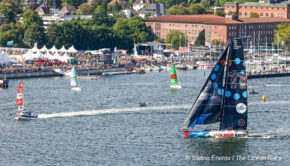Making Gender A Non-Factor
Published on August 30th, 2018
The competition story for the 2017-18 Volvo Ocean Race was in how after racing over 44,000 nautical miles around the world, the final leg had two teams tied at the top of the overall leaderboard with another just one point behind. This race was close!
But the event format also fostered a more enduring gender theme. Women had struggled for opportunities in past races, and the rules for this edition promoted their inclusion. As a result, 23 women are now offshore racing veterans.
“I think this edition of the race has been a major breakthrough,” said skipper Dee Caffari in the NY Times. “But for me the genuine test of whether this has worked is if in the next edition there are girls actually on crews and if girls are naturally selected, and I am skeptical that would happen if we don’t still have a rule.”
One person that didn’t need a rule was Jen Edney who was an onboard reporter for the 2017–2018 Volvo Ocean Race.
“It’s great that there is a push (for more female photographers in the industry), but my hope is that we get to a point that there is no need for one,” said Edney in Outside Magazine. “I wasn’t hired as the only female onboard reporter in a squad of ten because there was a quota to fill; it was because I had the right skill sets for the job.
“We (men and women) should be hired because we are best suited for the job, for our strength in content, creativity, skill sets, personality, and confidence to deliver, not because of our gender.”
Libby Greenhalgh, who was a navigator in the past two editions, sees the difference between being qualified and proving you are qualified. “I still think women have to go and do the next race as a team themselves and go out and perform and prove it. I think that’s really the only way some of these guys are going to go: ‘Hang on a minute. The women have actually just come second or third, and maybe we really do want to hire some people off that boat.”









 We’ll keep your information safe.
We’ll keep your information safe.